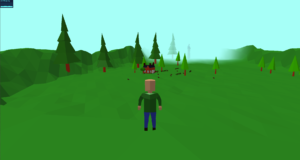As the last day of May comes to a close I thought I’d post the state of Penrith Forest right now:
It’s a little hard to tell from the screenshot but the character is standing on a hill, not just floating ominously. Anyway, you can see here that I’ve been taking advantage of the new terrain editing tools. I made a ring of mountains all the way around Penrith Forest. Right now you can just walk up and over them, but eventually they will be a barrier to players going where they aren’t allowed. I also added some more trees, although many more are needed. I’m a little torn because the trees in a little game you may or may not be familiar with are HUGE!
 The trees in Penrith Forest are big, but not that big. The great thing about huge trees is that they take up so much screen space and very easily keep the world from feeling empty. This is a technique I may have to use because in the screenshot above I increased the fog distance by about 200 meters so you can see pretty much everything at once but eventually I’d like to keep that distance fairly low and have assets load dynamically for efficiency’s sake. But if the world feels empty because you can only see things less than 100 meters away that’s not going to work. Maybe huge trees (and huge buildings, for that matter) will help take up a lot of screen space so that it feels like you are “somewhere” all the time. We’ll see.
The trees in Penrith Forest are big, but not that big. The great thing about huge trees is that they take up so much screen space and very easily keep the world from feeling empty. This is a technique I may have to use because in the screenshot above I increased the fog distance by about 200 meters so you can see pretty much everything at once but eventually I’d like to keep that distance fairly low and have assets load dynamically for efficiency’s sake. But if the world feels empty because you can only see things less than 100 meters away that’s not going to work. Maybe huge trees (and huge buildings, for that matter) will help take up a lot of screen space so that it feels like you are “somewhere” all the time. We’ll see.

